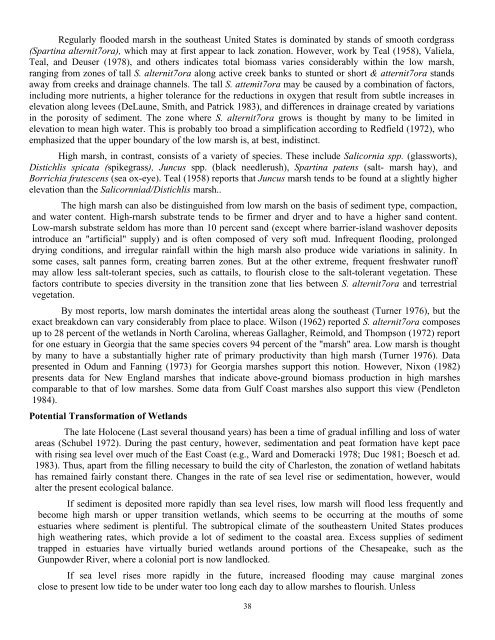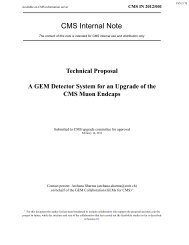Kana et al. 1988. S. Carolina Charleston SLR Case Study
Kana et al. 1988. S. Carolina Charleston SLR Case Study
Kana et al. 1988. S. Carolina Charleston SLR Case Study
You also want an ePaper? Increase the reach of your titles
YUMPU automatically turns print PDFs into web optimized ePapers that Google loves.
Regularly flooded marsh in the southeast United States is dominated by stands of smooth cordgrass<br />
(Spartina <strong>al</strong>ternit7ora), which may at first appear to lack zonation. However, work by Te<strong>al</strong> (1958), V<strong>al</strong>iela,<br />
Te<strong>al</strong>, and Deuser (1978), and others indicates tot<strong>al</strong> biomass varies considerably within the low marsh,<br />
ranging from zones of t<strong>al</strong>l S. <strong>al</strong>ternit7ora <strong>al</strong>ong active creek banks to stunted or short & atternit7ora stands<br />
away from creeks and drainage channels. The t<strong>al</strong>l S. attemit7ora may be caused by a combination of factors,<br />
including more nutrients, a higher tolerance for the reductions in oxygen that result from subtle increases in<br />
elevation <strong>al</strong>ong levees (DeLaune, Smith, and Patrick 1983), and differences in drainage created by variations<br />
in the porosity of sediment. The zone where S. <strong>al</strong>ternit7ora grows is thought by many to be limited in<br />
elevation to mean high water. This is probably too broad a simplification according to Redfield (1972), who<br />
emphasized that the upper boundary of the low marsh is, at best, indistinct.<br />
High marsh, in contrast, consists of a vari<strong>et</strong>y of species. These include S<strong>al</strong>icornia spp. (glassworts),<br />
Distichlis spicata (spikegrass), Juncus spp. (black needlerush), Spartina patens (s<strong>al</strong>t- marsh hay), and<br />
Borrichia frutescens (sea ox-eye). Te<strong>al</strong> (1958) reports that Juncus marsh tends to be found at a slightly higher<br />
elevation than the S<strong>al</strong>icornniad/Distichlis marsh..<br />
The high marsh can <strong>al</strong>so be distinguished from low marsh on the basis of sediment type, compaction,<br />
and water content. High-rnarsh substrate tends to be firmer and dryer and to have a higher sand content.<br />
Low-marsh substrate seldom has more than 10 percent sand (except where barrier-island washover deposits<br />
introduce an "artifici<strong>al</strong>" supply) and is often composed of very soft mud. Infrequent flooding, prolonged<br />
drying conditions, and irregular rainf<strong>al</strong>l within the high marsh <strong>al</strong>so produce wide variations in s<strong>al</strong>inity. In<br />
some cases, s<strong>al</strong>t pannes form, creating barren zones. But at the other extreme, frequent freshwater runoff<br />
may <strong>al</strong>low less s<strong>al</strong>t-tolerant species, such as cattails, to flourish close to the s<strong>al</strong>t-tolerant veg<strong>et</strong>ation. These<br />
factors contribute to species diversity in the transition zone that lies b<strong>et</strong>ween S. <strong>al</strong>ternit7ora and terrestri<strong>al</strong><br />
veg<strong>et</strong>ation.<br />
By most reports, low marsh dominates the intertid<strong>al</strong> areas <strong>al</strong>ong the southeast (Turner 1976), but the<br />
exact breakdown can vary considerably from place to place. Wilson (1962) reported S. <strong>al</strong>ternit7ora composes<br />
up to 28 percent of the w<strong>et</strong>lands in North <strong>Carolina</strong>, whereas G<strong>al</strong>lagher, Reimold, and Thompson (1972) report<br />
for one estuary in Georgia that the same species covers 94 percent of the "marsh" area. Low marsh is thought<br />
by many to have a substanti<strong>al</strong>ly higher rate of primary productivity than high marsh (Turner 1976). Data<br />
presented in Odum and Fanning (1973) for Georgia marshes support this notion. However, Nixon (1982)<br />
presents data for New England marshes that indicate above-ground biomass production in high marshes<br />
comparable to that of low marshes. Some data from Gulf Coast marshes <strong>al</strong>so support this view (Pendl<strong>et</strong>on<br />
1984).<br />
Potenti<strong>al</strong> Transformation of W<strong>et</strong>lands<br />
The late Holocene (Last sever<strong>al</strong> thousand years) has been a time of gradu<strong>al</strong> infilling and loss of water<br />
areas (Schubel 1972). During the past century, however, sedimentation and peat formation have kept pace<br />
with rising sea level over much of the East Coast (e.g., Ward and Domeracki 1978; Duc 1981; Boesch <strong>et</strong> ad.<br />
1983). Thus, apart from the filling necessary to build the city of <strong>Charleston</strong>, the zonation of w<strong>et</strong>land habitats<br />
has remained fairly constant there. Changes in the rate of sea level rise or sedimentation, however, would<br />
<strong>al</strong>ter the present ecologic<strong>al</strong> b<strong>al</strong>ance.<br />
If sediment is deposited more rapidly than sea level rises, low marsh will flood less frequently and<br />
become high marsh or upper transition w<strong>et</strong>lands, which seems to be occurring at the mouths of some<br />
estuaries where sediment is plentiful. The subtropic<strong>al</strong> climate of the southeastern United States produces<br />
high weathering rates, which provide a lot of sediment to the coast<strong>al</strong> area. Excess supplies of sediment<br />
trapped in estuaries have virtu<strong>al</strong>ly buried w<strong>et</strong>lands around portions of the Chesapeake, such as the<br />
Gunpowder River, where a coloni<strong>al</strong> port is now landlocked.<br />
If sea level rises more rapidly in the future, increased flooding may cause margin<strong>al</strong> zones<br />
close to present low tide to be under water too long each day to <strong>al</strong>low marshes to flourish. Unless<br />
38
















